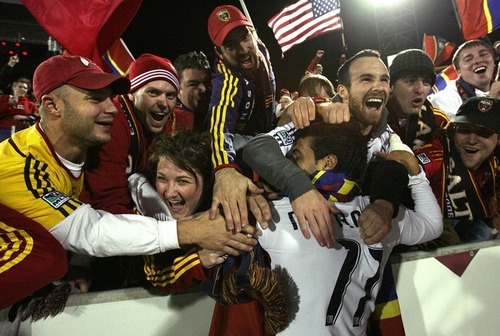This is an archived article that was published on sltrib.com in 2012, and information in the article may be outdated. It is provided only for personal research purposes and may not be reprinted.
Sandy • For years, people in the soccer community have wondered when — or even if — the growing legions of soccer-playing kids in America would evolve into serious fans who followed the game as they grew older.
Evidently, it's finally happening.
Attendance demographics and two significant studies have shown that Major League Soccer has one of the most youthful fan bases among pro sports in North America, suggesting that league officials have a right to feel encouraged about their continued growth and viability — even if their game surely will never be as popular in the United States as the NFL.
"There are 20-year-olds now who don't know life without Major League Soccer," said Dan Courtemanche, the league's vice president for communications. "Ten years ago, we couldn't have said that."
Two studies in recent years show that MLS and pro soccer are becoming increasingly popular with younger fans, an important factor in the game's future growth prospects.
Two years ago, a study by the Scarborough Sports Marketing firm showed that MLS had a greater percentage of its fans — 37.8 — in the cherished 18-to-34 age group than any other pro sport in North America.
And last year, a voluminous ESPN Sports Poll showed that among Americans age 12 to 24, pro soccer ranked as the second-most popular sport, behind the NFL.
"We've been saying for many years that soccer is young, diverse and digital," Courtemanche said. "But it surprised us that soccer ranked so high, behind the NFL — and that's for all Americans, at least in this statistical poll. … It was exciting to see that."
Of course, one key difference is that the NFL and other major pro sports have a far greater number of fans than MLS, whatever their demographic composition. The "pro soccer" in the ESPN poll included international teams, too.
But having a fan base so youthful is attractive to advertisers and sponsors, who are generally eager to associate with fans still forming their spending habits. It also endorses the widely held belief that the audience for the professional game in America will grow and mature as more and more kids grow up playing and watching soccer, with MLS as a backdrop in their lives.
"The long-term trends are all very positive for soccer, broadly speaking, and for MLS in particular," RSL general manager Garth Lagerwey said.
It probably hasn't hurt that broadcasting behemoth ESPN has helped validate the sport among traditional American fans by including it among its daily highlights and on its bottom-of-the-screen score ticker.
But Steve Herz, the president of the IF Management sports marketing firm in New York City, said the biggest factor has been the increasing diversity of the national population — particularly among the typically younger Hispanic and Latino communities.
"Those are the people who are playing soccer, and are going to be the fan base of the future," he said.
And the present, by the look of things.
Attendance at MLS games last year hit 17,872 on average, a league record that surpassed the average in the NBA (17,323) and the NHL (17,132) from last year, although both leagues play far more games. So far this year, league attendance is averaging 18,592 per game, with a record 19 teams and more soccer-specific stadiums than ever.
And while TV ratings for the league remained infinitesimal last year, compared with other sports — about 321,000 viewers per game on ESPN last year, and about 75,000 on Fox Soccer — they did rise significantly from the previous year.
Herz said he has been amazed at the interest he sees in soccer, anecdotally, in New York City, where the bars were packed with fans watching the dramatic final day of the English Premier League recently.
Admittedly, much of that interest centers on the international game, he said, but "enough of it is carrying over to MLS, where I feel like it's a slow but steady drift in the right direction for that league. And certainly in places like Portland and Seattle and Salt Lake City, the sport has become really popular. It has really attracted a tremendous, loyal following."
Most importantly, Courtemanche said the league has noticed a gradual change in the fans who attend MLS games.
While families remain a major presence, more and more young adults in that 18-to-34 age group have started to attend, helping build the enthusiastic supporters groups and contributing to a much greater knowledge of the game among fans at the games.
Long gone are the days when confused fans cheered at the wrong time, or loved the excitement of the league's now-defunct penalty-kick shootout — anathema to the "true" soccer fans, to whom the league now markets itself.
"Globally, people are now looking at MLS and saying, 'Wow, there are true football fans supporting that league in North America,' " Courtemanche said. "It's just a totally different dynamic that we've seen ... in maybe the last six or seven years. It makes it more exciting for everyone."
League officials looking to the future, not the least of them.
Twitter: @MCLTribune MLS' fan base
A Scarborough Sports Marketing study in 2009 showed MLS had a higher percentage of its fans in the coveted 18-34 demographic than any other pro sports league in North America.
League/Pct. fans 18-34
MLS • 37.8
NBA • 33.4
NFL • 31.9
NHL • 29.6
NASCAR • 29.4
MLB • 28.0



